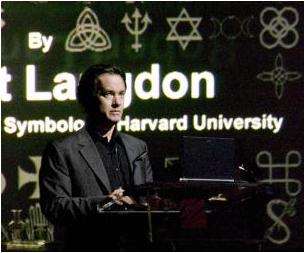See The X-Men Tree, another tree, and Trinity MOG.
Saturday, November 23, 2013
Saturday, February 5, 2022
Mathieu Cube Labeling
Shown below is an illustration from "The Puzzle Layout Problem" —
- September 2003
-
Lecture Notes in Computer Science 2912:500-501
DOI:10.1007/978-3-540-24595-7_50 - Source: DBLP
-
Conference: Graph Drawing, 11th International Symposium,
GD 2003, Perugia, Italy, September 21-24, 2003, Revised Papers - Authors: Kozo Sugiyama, Seok-Hee Hong, Atsuhiko Maeda

Exercise: Using the above numerals 1 through 24
(with 23 as 0 and 24 as ∞) to represent the points
∞, 0, 1, 2, 3 … 22 of the projective line over GF(23),
reposition the labels 1 through 24 in the above illustration
so that they appropriately* illustrate the cube-parts discussed
by Iain Aitchison in his March 2018 Hiroshima slides on
cube-part permutations by the Mathieu group M24.
A note for Northrop Frye —
Interpenetration in the eightfold cube — the three midplanes —
A deeper example of interpenetration:
Aitchison has shown that the Mathieu group M24 has a natural
action on the 24 center points of the subsquares on the eightfold
cube's six faces (four such points on each of the six faces). Thus
the 759 octads of the Steiner system S(5, 8, 24) interpenetrate
on the surface of the cube.
* "Appropriately" — I.e. , so that the Aitchison cube octads correspond
exactly, via the projective-point labels, to the Curtis MOG octads.
Sunday, December 2, 2018
Symmetry at Hiroshima
A search this morning for articles mentioning the Miracle Octad Generator
of R. T. Curtis within the last year yielded an abstract for two talks given
at Hiroshima on March 8 and 9, 2018 —
|
http://www.math.sci.hiroshima-u.ac.jp/ branched/files/2018/abstract/Aitchison.txt
Iain AITCHISON Title: Construction of highly symmetric Riemann surfaces, related manifolds, and some exceptional objects, I, II Abstract: Since antiquity, some mathematical objects have played a special role, underpinning new mathematics as understanding deepened. Perhaps archetypal are the Platonic polyhedra, subsequently related to Platonic idealism, and the contentious notion of existence of mathematical reality independent of human consciousness. Exceptional or unique objects are often associated with symmetry – manifest or hidden. In topology and geometry, we have natural base points for the moduli spaces of closed genus 2 and 3 surfaces (arising from the 2-fold branched cover of the sphere over the 6 vertices of the octahedron, and Klein's quartic curve, respectively), and Bring's genus 4 curve arises in Klein's description of the solution of polynomial equations of degree greater than 4, as well as in the construction of the Horrocks-Mumford bundle. Poincare's homology 3-sphere, and Kummer's surface in real dimension 4 also play special roles. In other areas: we have the exceptional Lie algebras such as E8; the sporadic finite simple groups; the division algebras: Golay's binary and ternary codes; the Steiner triple systems S(5,6,12) and S(5,8,24); the Leech lattice; the outer automorphisms of the symmetric group S6; the triality map in dimension 8; and so on. We also note such as: the 27 lines on a cubic, the 28 bitangents of a quartic curve, the 120 tritangents of a sextic curve, and so on, related to Galois' exceptional finite groups PSL2(p) (for p= 5,7,11), and various other so-called `Arnol'd Trinities'. Motivated originally by the `Eightfold Way' sculpture at MSRI in Berkeley, we discuss inter-relationships between a selection of these objects, illustrating connections arising via highly symmetric Riemann surface patterns. These are constructed starting with a labeled polygon and an involution on its label set. Necessarily, in two lectures, we will neither delve deeply into, nor describe in full, contexts within which exceptional objects arise. We will, however, give sufficient definition and detail to illustrate essential inter-connectedness of those exceptional objects considered. Our starting point will be simplistic, arising from ancient Greek ideas underlying atomism, and Plato's concepts of space. There will be some overlap with a previous talk on this material, but we will illustrate with some different examples, and from a different philosophical perspective. Some new results arising from this work will also be given, such as an alternative graphic-illustrated MOG (Miracle Octad Generator) for the Steiner system S(5,8,24), and an alternative to Singerman – Jones' genus 70 Riemann surface previously proposed as a completion of an Arnol'd Trinity. Our alternative candidate also completes a Trinity whose two other elements are Thurston's highly symmetric 6- and 8-component links, the latter related by Thurston to Klein's quartic curve. |
See also yesterday morning's post, "Character."
Update: For a followup, see the next Log24 post.
Monday, November 24, 2008
Monday November 24, 2008
Tuesday, February 27, 2007
Tuesday February 27, 2007

in “The Da Vinci Code”
yesterday, Feb. 26, 2007:
Mid-day 206
Evening 888
For more on the artistic
significance of 206,
see 2/06.
For more on the artistic
significance of 888, see
St. Bonaventure on the
Trinity at math16.com.
A trinity:

Click on picture for further details.
Sunday, November 21, 2004
Sunday November 21, 2004
Trinity and Counterpoint
Today's Roman Catholic meditation is from Gerry Adams, leader of Sinn Fein, the political arm of the Irish Republican Army:
"I certainly regret what happened and I make no bones about that," Adams said on the 30th anniversary of pub bombings that killed 21 on Nov. 21, 1974, in Birmingham, England.
Those who care what Roman Catholics think of the Trinity may read the remarks of St. Bonaventure at math16.com.
That site also offers a less holy but more intelligible trinity based on the irrefutable fact that
For a Protestant view of this trinity, see a website at the University of Birmingham in England.
That site's home page links to Birmingham's City Evangelical Church.
Sunday, June 15, 2003
Sunday June 15, 2003
Readings for Trinity Sunday

-
Triune knot:
Problems in Combinatorial Group Theory, 7 and 8, in light of the remark in Section 8.3 of Lattice Polygons and the Number 12 -
Cardinal Newman:
Sermon 24 -
Simon Nickerson:
24=8×3.
For more on the structure
discussed by Nickerson, see
For theology in general, see




